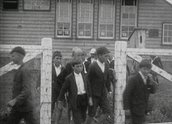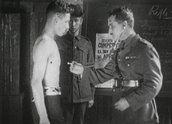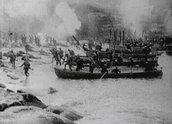


The Spirit of Gallipoli (1928)
Synopsis
Billy Austin (Keith Gategood) has grown up carefree and undisciplined on the outskirts of Sydney. His mother and father despair until he is called up to compulsory training in the Army. At Liverpool camp, Billy and his best mate Jack (William Green) learn the benefits of self-discipline through training. Billy reads a book about the exploits of Australian soldiers in the First World War and is inspired by the landings at Gallipoli. He straightens himself up, winning the heart of local girl Gladys (Marie Miller). They settle into a good life on a farm.
Curator’s notes
Very little is known about why Keith Gategood and his friend William Green decided to make The Spirit of Gallipoli in 1928, but we are fortunate that they did, because they have helped to preserve fragments of an earlier and more important film, Alfred Rolfe’s 1915 production, The Hero of the Dardanelles, most of which is now lost.
The Spirit of Gallipoli is clearly intended as a recruiting film for the AMF, the Australian Military Forces. An opening title tells us that these men were trainees of the 55th Battalion, with no previous film experience. Clearly the film was made with the battalion’s blessing, perhaps even at its instigation. It emphasises comradeship, discipline and training, rather than warfare. Our hero Billy Austin never gets to fight, except in a regimental boxing match, in which he knocks out a bigger and meaner opponent.
The spectre of war comes in a dream sequence after he has been given a book about Australia’s exploits in the First World War. He dreams of Gallipoli, but rather than trying to restage a landing, the filmmakers simply borrowed one that had already been shot – from Alfred Rolfe’s film. This cannabilising of an earlier film was very common in the silent era.
Rolfe restaged the Gallipoli landing in Sydney a few weeks after the actual event. He used soldiers from Liverpool camp, the same camp we see in this film, made 13 years later.
Such was the excitement in Australia in 1915 about the campaign on Gallipoli that two feature films were made in Sydney at the same time, by competing companies. Alfred Rolfe restaged his landing at Tamarama Beach in Sydney, for Australasian Films, with substantial help from the Department of Defence. The second film, Within Our Gates, or Deeds that Won Gallipoli (1915), was directed by imported English actor, writer and director Frank Harvey, for JC Williamson’s. He restaged a landing at Obelisk Bay in the calmer waters of Sydney Harbour. Most of that film is now thought lost, save for a few seconds. Rolfe’s film was partially preserved – but without his landing footage.
Both films had successful runs around the country. It appears they were then shelved and forgotten, at least for some years. Both had been made as an aid to recruitment, but horrendous casualty figures made recruitment films less popular. By the end of the war, they were box-office poison. Ten years later, the mood had changed again. Australia lost 60,000 men in that war and there was a strong push towards formalised methods of remembrance, such as the annual procession on Anzac Day, 25 April. The tenth anniversary of the Armistice was going to be a major event in that remembrance.
It may be that The Spirit of Gallipoli was made to coincide with that anniversary. It is certainly another kind of recruiting film. Most battalions had been reorganised and many were decommissioned after the war. Recruits to the civilian-based Australian Military Forces (AMF) dropped off considerably, and this film appears to be addressing that need. It stresses the benefits of military training, rather than the responsibilities of actual fighting. These men do not have to go to war, but they benefit from the lessons of soldiering, and from learning about the history of the great deeds of 1914–18. In effect, Billy becomes a man rather than a boy and gets the girl. The final scenes show him happily married with a dairy farm.
There were two films released in 1928, both of which borrowed footage from Alfred Rolfe’s 1915 film. The Spirit of Gallipoli was released first, at the Piccadilly Theatre in Sydney on 17 March 1928, by Fox Film Corporation. According to Australian Film 1900–1977, by Andrew Pike and Ross Cooper (1980, Oxford University Press), the film attracted little attention.
The second film, simply called Gallipoli, was a compilation put together by an Australian motion picture entrepreneur, Arthur Tinsdale, who had been living in London for some years. He returned to Australia in April 1928, carrying a film that was described in press reports as 130,000 feet in length. Other press reports indicate that it had its first screening in Melbourne in June and it now included footage shot in Melbourne on Anzac Day, 1928. It also contained footage of a landing at Gallipoli – we now believe that this footage comes from the Rolfe film, the same as in The Spirit of Gallipoli. In short, two films of 1928 made use of Rolfe’s landing footage, and thus helped to preserve it.
Tinsdale’s Gallipoli is considered a British film, although it was made by an Australian, largely for exploitation in Australia around the 1928 anniversary. That may be part of why it has remained unidentified here in Australia.
In 1938, an engineer called Alexander Henry Noad (born 1900 in Windsor, NSW) sold a reel of assorted Great War footage to the Australian War Memorial. This footage has remained unidentified for the last 75 years, until now. The Noad film is significant, because it contains previously unrecognised fragments of footage shot by the English war correspondent, Ellis Ashmead-Bartlett, during the middle of the Gallipoli campaign, in July and August 1915. That was noticed in 2007 by staff at the Australian War Memorial, and greeted with considerable excitement.
Ashmead-Bartlett’s film is considered the only footage taken on Gallipoli during the actual fighting. The Australian war historian Charles Bean re-edited a copy of the Ashmead-Bartlett film in 1919, rewriting many of the titles for Australian consumption, and mislabelling a number of scenes. The fragments from the Noad film added to that 1919 version. That must mean that the Noad film contains footage from before Bean recut Ashmead-Bartlett’s original.
What no-one recognised was the origin of the Noad film. That mystery is now solved. The Noad film is Arthur Tinsdale’s Gallipoli, from 1928, or a version of it. Tinsdale wrote to the war memorial to ask for their help in the making of his film, Gallipoli, which was to bring together footage from a large variety of sources and countries. He sent a detailed description of what his film would be, with pages of titles. Comparing that document with the Noad film gives a word-for-word match across a number of titles. Further comparisons of the Noad film with reviews of Tinsdale’s Gallipoli published in newspapers of the time also confirm that hypothesis. The Noad film does not follow Tinsdale’s document scene by scene, but that document was just a plan. In the Noad film, the order of several key scenes has changed, but a number of the titles survive intact.
We do not know how Noad got hold of Tinsdale’s film. By 1942, Noad was in the film industry, working as a newsreel cameraman, so he may have been working in that role for some time. The Noad film is a potentially rich resource for newsreels. Its European war footage would have been useful to editors looking for scenes to illustrate the Great War. That’s at least a plausible thesis for how Noad came to have it.
One of the intriguing questions still to be answered is where Tinsdale obtained Alfred Rolfe’s landing footage from 1915. One possibility is that he got the footage from The Spirit of Gallipoli, which came and went from theatres before he was ready to show his film in 1928. The other possibility is that he took it directly from a copy of Rolfe’s film. A third possibility is that he mixed footage from both films shot in 1915, and both restaged landings, Obelisk Bay and Tamarama. A fourth possibility is that Rolfe’s footage was used by someone else after the war, and the footage came down to both of these 1928 films from that second user. That would explain one anomaly (see clip 3).
We can rule out the first idea because the Noad/Tinsdale film contains more complete scenes than The Spirit of Gallipoli. It is clear that both films used the same source, but the Noad/Tinsdale film contains longer versions of the scenes used in both films. The second, third and fourth possibilities require more research before they can be either verified or disproved.
For more on Australian film representations of the Gallipoli campaign, see Gallipoli on Film
- Overview
- Curator’s notes
- Video 3 clips
- Principal credits
- Find a copy
- Make a comment
- Map
- Add your review



